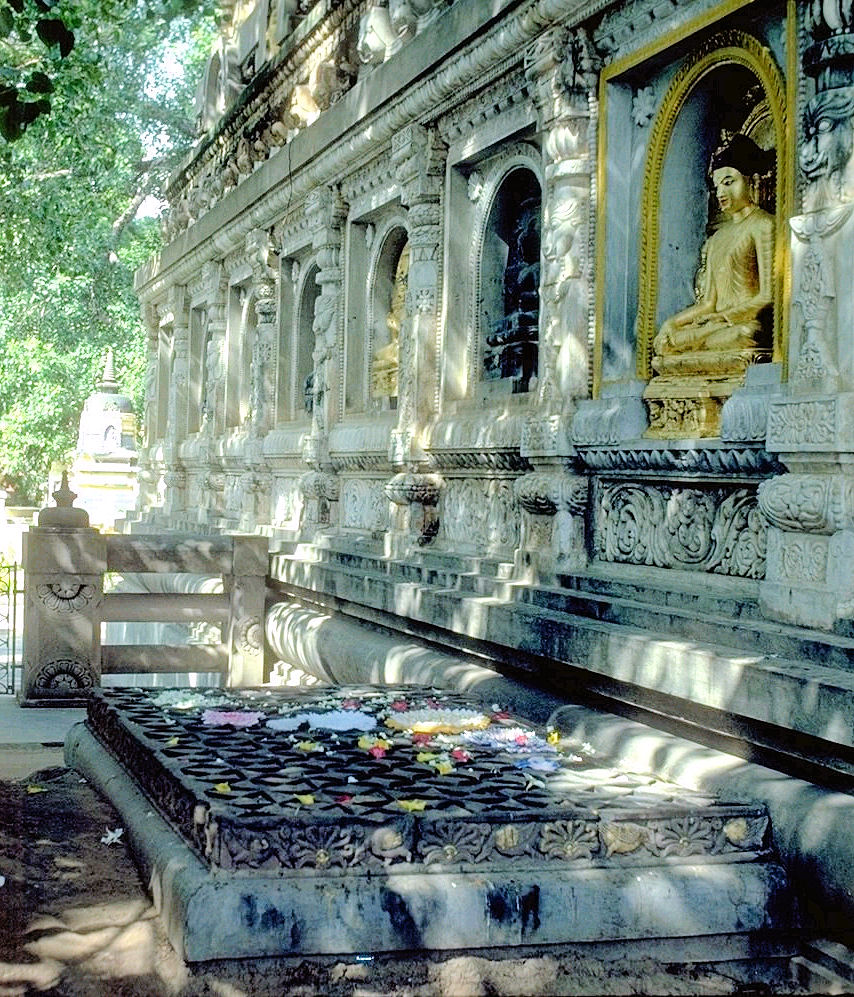Bodhimaṇḍa on:
[Wikipedia]
[Google]
[Amazon]

 Bodhimaṇḍa (
Bodhimaṇḍa (

 Bodhimaṇḍa (
Bodhimaṇḍa (Sanskrit
Sanskrit (; attributively , ; nominally , , ) is a classical language belonging to the Indo-Aryan languages, Indo-Aryan branch of the Indo-European languages. It arose in South Asia after its predecessor languages had Trans-cultural diffusion ...
and Pali
Pali () is a Middle Indo-Aryan liturgical language native to the Indian subcontinent. It is widely studied because it is the language of the Buddhist ''Pāli Canon'' or '' Tipiṭaka'' as well as the sacred language of '' Theravāda'' Buddh ...
) or daochang () is a term used in Buddhism
Buddhism ( , ), also known as Buddha Dharma and Dharmavinaya (), is an Indian religion or philosophical tradition based on teachings attributed to the Buddha. It originated in northern India as a -movement in the 5th century BCE, and ...
meaning the "position of awakening". According to Haribhadra, it is "a place used as a seat, where the essence of enlightenment is present".
Bodhimaṇḍas are regularly visited by Buddhist pilgrims, and some have gone on to become popular secular tourist
Tourism is travel for pleasure or business; also the theory and practice of touring, the business of attracting, accommodating, and entertaining tourists, and the business of operating tours. The World Tourism Organization defines tourism ...
destinations as well. In many forms of Buddhism, it is believed that bodhimaṇḍas are spiritually pure places, or otherwise conducive to meditation and enlightenment.
Famous bodhimaṇḍas in India
* TheVajrasana, Bodh Gaya
The Vajrasana (; ''diamond throne''), or Enlightenment Throne of the Buddha, is an ancient stone slab located under the Bodhi tree, directly beside the Mahabodhi Temple at Bodh Gaya. The slab is thought to have been placed at Bodhgayā by emper ...
: Gautama Buddha
Siddhartha Gautama, most commonly referred to as the Buddha, was a wandering ascetic and religious teacher who lived in South Asia during the 6th or 5th century BCE and founded Buddhism.
According to Buddhist tradition, he was born in L ...
* Mount Potalaka: Avalokiteśvara
In Buddhism, Avalokiteśvara (Sanskrit: अवलोकितेश्वर, IPA: ) is a bodhisattva who embodies the compassion of all Buddhas. He has 108 avatars, one notable avatar being Padmapāṇi (lotus bearer). He is variably depicted, ...
Bodhisattva
Famous bodhimaṇḍas in China
*Mount Putuo
Mount Putuo (, from Sanskrit: " Mount Potalaka") is an island in Putuo District, Zhoushan, Zhejiang, China. It is a renowned site in Chinese Buddhism and is the bodhimaṇḍa of the bodhisattva Guanyin.
Mount Putuo is one of the four sa ...
: Avalokiteśvara
In Buddhism, Avalokiteśvara (Sanskrit: अवलोकितेश्वर, IPA: ) is a bodhisattva who embodies the compassion of all Buddhas. He has 108 avatars, one notable avatar being Padmapāṇi (lotus bearer). He is variably depicted, ...
Bodhisattva
* Mount Emei
Mount Emei (; ), alternately Mount Omei, is a mountain in Sichuan Province, China, and is the highest of the Four Sacred Buddhist Mountains of China. Mount Emei sits at the western rim of the Sichuan Basin. The mountains west of it are kn ...
: Samantabhadra Bodhisattva
* Mount Wutai
Mount Wutai, also known by its Chinese name Wutaishan and as is a sacred Buddhist site at the headwaters of the Qingshui in Shanxi Province, China. Its central area is surrounded by a cluster of flat-topped peaks roughly corresponding to the ...
: Mañjuśrī
Mañjuśrī ( Sanskrit: मञ्जुश्री) is a ''bodhisattva'' associated with '' prajñā'' (wisdom) in Mahāyāna Buddhism. His name means "Gentle Glory" in Sanskrit. Mañjuśrī is also known by the fuller name of Mañjuśrīkumār ...
Bodhisattva
* Mount Jiuhua: Kṣitigarbha
Kṣitigarbha ( sa, क्षितिगर्भ, , bo, ས་ཡི་སྙིང་པོ་ Wylie: ''sa yi snying po'') is a bodhisattva primarily revered in East Asian Buddhism and usually depicted as a Buddhist monk. His name may be t ...
Bodhisattva
See also
*Dojo
A is a hall or place for immersive learning or meditation. This is traditionally in the field of martial arts, but has been seen increasingly in other fields, such as meditation and software development. The term literally means "place of the ...
and dojang
''Dojang'' is a term used in Korean martial arts, such as Taekwondo, Tang Soo Do, Kuk Sool Won, and hapkido, that refers to a formal training hall. It is typically considered the formal gathering place for students of a martial art to cond ...
, two types of buildings whose names are written with the same Chinese characters used for ''daochang''
References
Buddhist philosophical concepts {{Buddhism-stub